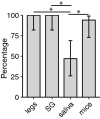Saliva collection via capillary method may underestimate arboviral transmission by mosquitoes
- PMID: 35331315
- PMCID: PMC8944160
- DOI: 10.1186/s13071-022-05198-7
Saliva collection via capillary method may underestimate arboviral transmission by mosquitoes
Abstract
Background: Arthropod-borne viruses (arboviruses) impose a major health and economic burden on human populations globally, with mosquitoes serving as important vectors. Measuring the ability of a mosquito population to transmit an arbovirus is important in terms of evaluating its public health risk. In the laboratory, a variety of methods are used to estimate arboviral transmission by mosquitoes, including indirect methods involving viral detection from mosquito saliva collected by forced salivation. The accuracy of indirect methods to estimate arbovirus transmission to live animal hosts has not been fully evaluated.
Methods: We compared three commonly used proxies of arboviral transmission, namely, the presence of virus in mosquito legs, in salivary glands (SG) and in saliva collected in capillary tubes using forced salivation, with direct transmission estimates from mosquitoes to suckling mice. We analyzed five vector-virus combinations, including Aedes aegypti infected with chikungunya virus, West Nile virus and Zika virus; Culex quinquefasciatus infected with West Nile virus; and Aedes triseriatus infected with La Crosse virus.
Results: Comparatively, the methods of detecting virus infection in mosquito legs and in SG were equally accurate in predicting transmission. Overall, the presence of virus in mosquito legs was a more accurate predictor of transmission than the commonly implemented viral detection method using forced salivation into a capillary tube, and was subject to less technical variation.
Conclusions: These results suggest that, in general, forced salivation methods tend to underestimate virus transmission, and they provide confidence in the use of mosquito leg screens to evaluate the transmission potential of a mosquito population.
Keywords: Arbovirus; Proxy; Saliva; Transmission; Vector.
© 2022. The Author(s).
Conflict of interest statement
The authors declare that they have no competing interests.
Figures





Similar articles
-
Bidirectional Interactions between Arboviruses and the Bacterial and Viral Microbiota in Aedes aegypti and Culex quinquefasciatus.mBio. 2022 Oct 26;13(5):e0102122. doi: 10.1128/mbio.01021-22. Epub 2022 Sep 7. mBio. 2022. PMID: 36069449 Free PMC article.
-
Microbial Composition in Larval Water Enhances Aedes aegypti Development but Reduces Transmissibility of Zika Virus.mSphere. 2021 Dec 22;6(6):e0068721. doi: 10.1128/msphere.00687-21. Epub 2021 Dec 8. mSphere. 2021. PMID: 34878293 Free PMC article.
-
Cell-Fusing Agent Virus Reduces Arbovirus Dissemination in Aedes aegypti Mosquitoes In Vivo.J Virol. 2019 Aug 28;93(18):e00705-19. doi: 10.1128/JVI.00705-19. Print 2019 Sep 15. J Virol. 2019. PMID: 31243123 Free PMC article.
-
Aedes Mosquito Salivary Components and Their Effect on the Immune Response to Arboviruses.Front Cell Infect Microbiol. 2020 Aug 7;10:407. doi: 10.3389/fcimb.2020.00407. eCollection 2020. Front Cell Infect Microbiol. 2020. PMID: 32850501 Free PMC article. Review.
-
Antiviral Compounds for Blocking Arboviral Transmission in Mosquitoes.Viruses. 2021 Jan 14;13(1):108. doi: 10.3390/v13010108. Viruses. 2021. PMID: 33466915 Free PMC article. Review.
Cited by
-
Potential of Ilhéus virus to emerge.Heliyon. 2024 Mar 16;10(6):e27934. doi: 10.1016/j.heliyon.2024.e27934. eCollection 2024 Mar 30. Heliyon. 2024. PMID: 38545168 Free PMC article.
-
The effect of repeat feeding on dengue virus transmission potential in Wolbachia-infected Aedes aegypti following extended egg quiescence.PLoS Negl Trop Dis. 2024 Jul 8;18(7):e0012305. doi: 10.1371/journal.pntd.0012305. eCollection 2024 Jul. PLoS Negl Trop Dis. 2024. PMID: 38976758 Free PMC article.
-
Developing Wolbachia-based disease interventions for an extreme environment.PLoS Pathog. 2023 Jan 31;19(1):e1011117. doi: 10.1371/journal.ppat.1011117. eCollection 2023 Jan. PLoS Pathog. 2023. PMID: 36719928 Free PMC article.
-
AG129 Mice as a Comprehensive Model for the Experimental Assessment of Mosquito Vector Competence for Arboviruses.Pathogens. 2022 Aug 3;11(8):879. doi: 10.3390/pathogens11080879. Pathogens. 2022. PMID: 36015000 Free PMC article.
-
Field Isolation and Laboratory Vector-Host Studies of Brazoran Virus (Peribunyaviridae: Orthobunyavirus) from Florida.Am J Trop Med Hyg. 2024 Mar 26;110(5):968-970. doi: 10.4269/ajtmh.23-0799. Print 2024 May 1. Am J Trop Med Hyg. 2024. PMID: 38531101
References
MeSH terms
Grants and funding
LinkOut - more resources
Full Text Sources
Medical

